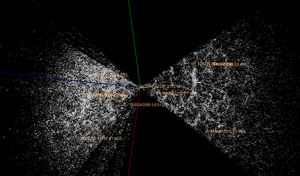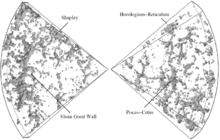2dF Galaxy Redshift Survey

In astronomy, the 2dF Galaxy Redshift Survey (Two-degree-Field Galaxy Redshift Survey), 2dF or 2dFGRS is a redshift survey conducted by the Anglo-Australian Observatory (AAO) with the 3.9m Anglo-Australian Telescope between 1997 and 11 April 2002.[1] The data from this survey were made public on 30 June 2003. The survey determined the large-scale structure in one section of the local Universe. As of Jaunary 2007, it is the second largest redshift survey next to the Sloan Digital Sky Survey which began in 2000. Steve Maddox and John Peacock were in charge of the project.
Description
The 2dF survey covered an area of about 1500 square degrees, surveying regions in both the north and the south galactic poles.[2] The name derives from the fact that the survey instrument covers an area of approximately two square degrees.
The areas selected for observation were previously surveyed by the massive APM Galaxy Survey (on which Steve Maddox also worked).[2] The regions surveyed cover roughly 75 degrees of right ascension for both bands, and the declination of the North Polar band was about 7.5 degrees while the declination of the South Polar band was about 15 degrees. Hundreds of isolated two degree fields near the South Polar band were also surveyed (see this illustration, where black circles represent survey fields, and the red grid represents the earlier APM survey).
In total, the photometry of 382,323 objects were measured, which includes spectra for 245,591 objects, of which 232,155 were galaxies (221,414 with good quality spectra), 12,311 are stars, and 125 are quasi-stellar objects (quasars).[3] The survey necessitated 272 required nights of observation, spread over 5 years.
The survey was carried out with the 4 metre Anglo-Australian Telescope, with the 2dF instrument installed at the primary focus permitting the observation of a field of 2 degrees per pointing. The instrument possesses a spectrograph equipped with two banks each of 200 optical fibres, permitting the simultaneous measurement of 400 spectra. The limiting apparent magnitude of the survey is 19.5, covering objects with a redshift mostly within less than z=0.3 and a median redshift of 0.11. The volume of the Universe covered by the survey is approximately 108 h-1 Mpc3, where h corresponds to the value of the Hubble constant, H0, divided by 100. H0 is approximately 70 km/s/Mpc. The largest redshift observed by the survey corresponds to a distance of 600 h-1 Mpc.
Survey Results
The principal results obtained for the field of cosmology by the 2dF survey are:
- The measurement of the density parameter of non-relativistic matter (baryonic matter plus dark matter plus massive neutrinos)
- The detection of acoustic oscillations of baryons, and as a consequence the relationship between the density of baryonic matter and dark matter
- Limits on the contribution of massive neutrinos to dark matter, putting a limit on the sum of the masses of the three families of neutrinos at 1.8 eV.
All these results are in agreement with the measurements of other experiments, notably those of WMAP. They confirm the standard cosmological model.
The 2dF survey also yields a unique view on our local cosmic environment. Below a 3-D reconstruction of the inner parts of the survey is shown, revealing an impressive view on the cosmic structures in the nearby universe. Several superclusters stand out, such as the Sloan Great Wall, the largest structure in the universe known to date.

See also
Notes
External links
- Official site of the 2dF Galaxy Redshift Survey
- The 2dF Galaxy Redshift Survey: spectra and redshifts − 2001 Royal Astronomical Society paper describing the survey
- Official site of the Two Degree Field instrument system
